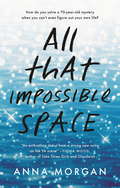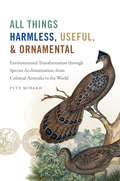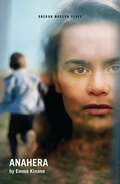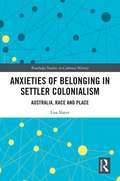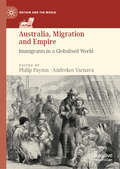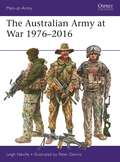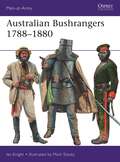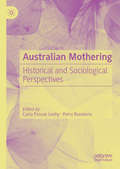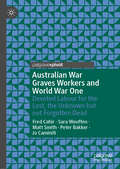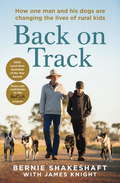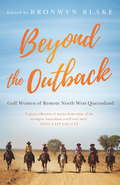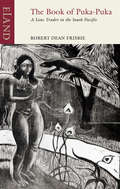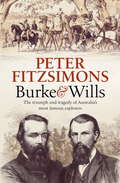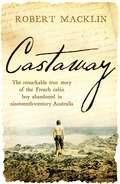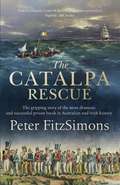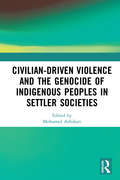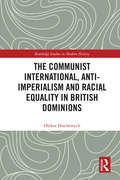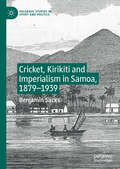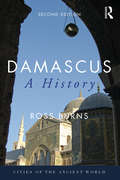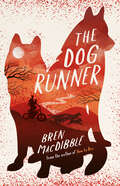- Table View
- List View
All That Impossible Space
by Anna MorganAmelia Westlake meets My Favorite Murder in this debut from a terrific new voice in Australian YA. Combines a realistic story about high school drama and toxic friendship with true crime - the endlessly fascinating Somerton Man or Tamam Shud mystery.15-year-old Lara Laylor feels like supporting character in her own life. She's Ashley's best friend, she's Hannah's sister-she's never just Lara. When new history teacher Mr. Grant gives her an unusual assignment: investigating the mystery of the Somerton Man. Found dead in on an Adelaide beach in 1948, a half-smoked cigarette still in his mouth and the labels cut out of his clothes, the Somerton Man has intrigued people for years. Was he a spy? A criminal? Year 10 has plenty of mysteries of its own: boys, drama queen friends, and enigmatic new students. When they seem just as unsolvable as a 60-year-old cold case, Lara finds herself spending more and more time on the assignment. But Mr Grant himself may be the biggest mystery of all...Interspersed with fictionalised snapshots of the Somerton Man investigation, ALL THAT IMPOSSIBLE SPACE is a coming of age novel exploring toxic friendships and the balance of power between teacher and student, perfect for fans of Cath Crowley and Fiona Wood.
All Things Harmless, Useful, and Ornamental: Environmental Transformation through Species Acclimatization, from Colonial Australia to the World (Flows, Migrations, and Exchanges)
by Pete MinardSpecies acclimatization--the organized introduction of organisms to a new region--is much maligned in the present day. However, colonization depended on moving people, plants, and animals from place to place, and in centuries past, scientists, landowners, and philanthropists formed acclimatization societies to study local species and conditions, form networks of supporters, and exchange supposedly useful local and exotic organisms across the globe. Pete Minard tells the story of this movement, arguing that the colonies, not the imperial centers, led the movement for species acclimatization. Far from attempting to re-create London or Paris, settlers sought to combine plants and animals to correct earlier environmental damage and to populate forests, farms, and streams to make them healthier and more productive. By focusing particularly on the Australian colony of Victoria, Minard reveals a global network of would-be acclimatizers, from Britain and France to Russia and the United States. Although the movement was short-lived, the long reach of nineteenth-century acclimatization societies continues to be felt today, from choked waterways to the uncontrollable expansion of European pests in former colonies.
Anahera (Oberon Modern Plays)
by Emma Kinane11-year-old Harry Hunter is missing. While they wait for news, Anahera – a newly qualified Māori social worker – supports Harry’s distraught parents. But as the hours pass and the situation pushes everyone to their limits, Anahera is forced to take a stand. A European debut for an exciting new voice from New Zealand
Anxieties of Belonging in Settler Colonialism: Australia, Race and Place (Routledge Studies in Cultural History #65)
by Lisa SlaterThis book analyses the anxiety "well-intentioned" settler Australian women experience when engaging with Indigenous politics. Drawing upon cultural theory and studies of affect and emotion, Slater argues that settler anxiety is an historical subjectivity which shapes perception and senses of belonging. Why does Indigenous political will continue to provoke and disturb? How does settler anxiety inform public opinion and "solutions" to Indigenous inequality? In its rigorous interrogation of the dynamics of settler colonialism, emotions and ethical belonging, Anxieties of Belonging has far-reaching implications for understanding Indigenous-settler relations.
Anxieties of Belonging in Settler Colonialism: Australia, Race and Place (Routledge Studies in Cultural History #65)
by Lisa SlaterThis book analyses the anxiety "well-intentioned" settler Australian women experience when engaging with Indigenous politics. Drawing upon cultural theory and studies of affect and emotion, Slater argues that settler anxiety is an historical subjectivity which shapes perception and senses of belonging. Why does Indigenous political will continue to provoke and disturb? How does settler anxiety inform public opinion and "solutions" to Indigenous inequality? In its rigorous interrogation of the dynamics of settler colonialism, emotions and ethical belonging, Anxieties of Belonging has far-reaching implications for understanding Indigenous-settler relations.
Australia, Migration and Empire: Immigrants in a Globalised World (Britain and the World)
by Philip Payton Andrekos VarnavaThis edited collection explores how migrants played a major role in the creation and settlement of the British Empire, by focusing on a series of Australian case studies. Despite their shared experiences of migration and settlement, migrants nonetheless often exhibited distinctive cultural identities, which could be deployed for advantage. Migration established global mobility as a defining feature of the Empire. Ethnicity, class and gender were often powerful determinants of migrant attitudes and behaviour. This volume addresses these considerations, illuminating the complexity and diversity of the British Empire’s global immigration story. Since 1788, the propensity of the populations of Britain and Ireland to immigrate to Australia varied widely, but what this volume highlights is their remarkable diversity in character and impact. The book also presents the opportunities that existed for other immigrant groups to demonstrate their loyalty as members of the (white) Australian community, along with notable exceptions which demonstrated the limits of this inclusivity.
The Australian Army at War 1976–2016 (Men-at-Arms #526)
by Leigh NevilleSince the end of their involvement in the Vietnam War, the Australian Army has been modernized in every respect. After peacekeeping duties in South-East Asia, Africa and the Middle East in the 1980s–90s, 'Diggers' were sent to safeguard the newly independent East Timor from Indonesian harassment in 1999, and to provide long-term protection and mentoring since 2006. Australian Army units have served in the US-led wars in Iraq and Afghanistan, and Australian Special Forces are currently operating alongside US and British elements against ISIS in northern Iraq. During these campaigns the Australian SAS Regiment and Commandos have fully matured into 'Tier 1' assets, internationally recognized for their wide range of capabilities. The book, written by an Australian author who has written extensively about modern warfare, traces the development of the Army's organization, combat uniforms, load-bearing equipment, small arms and major weapon systems using specially commissioned artwork and photographs.
Australian Bushrangers 1788–1880 (Men-at-Arms)
by Ian KnightThe first 'bushrangers' or frontier outlaws were escaped or time-expired convicts, who took to the wilderness – 'the bush' – in New South Wales and on the island of Tasmania. Initially, the only Crown forces available were redcoats from the small, scattered garrisons, but by 1825 the problem of outlawry led to the formation of the first Mounted Police from these soldiers. The gold strikes of the 1860s attracted a new group of men who preferred to get rich by the gun rather than the shovel. The roads, and later railways, that linked the mines with the cities offered many tempting targets and were preyed upon by the bushrangers. This 1860s generation boasted many famous outlaws who passed into legend for their boldness. The last outbreak came in Victoria in 1880, when the notorious Kelly Gang staged several hold-ups and deliberately ambushed the pursuing police. Their last stand at Glenrowan has become a legendary episode in Australian history. Fully illustrated with some rare period photographs, this is the fascinating story of Australia's most infamous outlaws and the men tasked with tracking them down.
Australian Mothering: Historical and Sociological Perspectives
by Carla Pascoe Leahy Petra BueskensThis collection defines the field of maternal studies in Australia for the first time. Leading motherhood researchers explore how mothering has evolved across Australian history as well as the joys and challenges of being a mother today. The contributors cover pregnancy, birth, relationships, childcare, domestic violence, time use, work, welfare, policy and psychology, from a diverse range of maternal perspectives. Utilising a matricentric feminist framework, Australian Mothering foregrounds the experiences, emotions and perspectives of mothers to better understand how Australian motherhood has developed historically and contemporaneously. Drawing upon their combined sociological and historical expertise, Bueskens and Pascoe Leahy have carefully curated a collection that presents compelling research on past and present perspectives on maternity in Australia, which will be relevant to researchers, advocates and policy makers interested in the changing role of mothers in Australian society.
Australian War Graves Workers and World War One: Devoted Labour for the Lost, the Unknown but not Forgotten Dead
by Fred Cahir Sara Weuffen Matt Smith Peter Bakker Jo CaminitiThis book relays the largely untold story of the approximately 1,100 Australian war graves workers whose job it was to locate, identify exhume and rebury the thousands of Australian soldiers who died in Europe during the First World War. It tells the story of the men of the Australian Graves Detachment and the Australian Graves Service who worked in the period 1919 to 1922 to ensure that grieving families in Australia had a physical grave which they could mourn the loss of their loved ones. By presenting biographical vignettes of eight men who undertook this work, the book examines the mechanics of the commemoration of the Great War and extends our understanding of the individual toll this onerous task took on the workers themselves.
Back on Track: How one man and his dogs are changing the lives of rural kids
by James Knight Bernie ShakeshaftAs a kid, Bernie Shakeshaft's mischievous and reckless behaviour led him to became known as the wild one of his devout Catholic family. It isn't surprising that his path led him to the Northern Territory, a place where people often go to either lose themselves or find themselves. Bernie, a searcher for his purpose in life, found himself.He had many jobs, firstly as a ringer on a cattle station owned by the Packer family, and later as a dingo trapper for the Parks and Wildlife Service. Throughout it all, he drank, he swore, he fought, and took chances with his own well-being. But, crucially, he also developed deep connections with the Indigenous people, and it was these connections that helped lay the foundations for what was to come. He worked for youth welfare organisations, and all the while he built up his knowledge about helping wayward youths, particularly those from Indigenous communities.Years later, Bernie was living in Armidale. He'd been visiting too many kids in prison and going to too many funerals. The usual methods weren't working so that reckless, mischievous kid inside him decided he could do better. He started a youth program called BackTrack, with three aims: To keep them alive, out of jail and chasing their hopes and dreams. For most, this was their last chance. Combining life skills, education, job preparedness with rural work, Bernie threw in one other factor: dogs! And it works. With the help of these working dogs, the lost boys (and girls) find their way back on track. These days, Backtrack youth tour the country competing in dog-jumping trials. Bernie and the BackTrack team are now supporting other communities in Lake Cargelligo, Broken Hill, Dubbo and Grafton and have forged a new beginning for over 1000 young people. This one man is making a huge difference.In Back on Track, bestselling author James Knight tells Bernie's story and the stories of those whose lives he has saved. It is a powerful reminder that we should never give up on our kids.'This fella Bernie, he's a good fella, a bit of a genius really. What a great story.' - Russell Crowe
Beyond the Outback: Gulf Women of Remote North West Queensland
by Bronwyn BlakeTwenty women share their incredible stories of surviving and thriving in the remote Australian 'Gulf Country', near the Gulf of Carpentaria.Gulf women are self-sufficient, generous, and can cope with almost anything that life and the environment throws at them: floods, drought, sickness, emergencies. Whether they are graziers, fisherwomen, ringers, women in tourism, aviation and education, Indigenous women or descendants from early women settlers, this powerful book gives these women a voice to tell their own stories.There are stories of new mothers on properties isolated and inaccessible for months in the wet season; women giving birth at home with only neighbours to assist; reminiscences from last century and World War II, and accounts of fishing in the Gulf in sometimes unimaginable conditions.From the kids wanting a baby croc for a pet to the terror of a snake bite with a flooded airstrip and impassable roads, these women treat the extraordinary events in their lives as just part of their remote way of life.Set in a world of vast landscapes, distance and merciless climate, Beyond the Outback contains riveting tales of the lives of the women who live, work and raise families in one of Australia's most isolated regions. It will be loved by readers of Sara Henderson, Toni Tapp Coutts and Terry Underwood.
The Book of Puka-Puka: A Lone Trader in the South Pacific
by Robert Dean FrisbieIn 1924, Robert Frisbie arrived on the island of Puka-Puka, one of the most remote in the South Pacific, to run a trading post. Within months he had learned the language and become absorbed into the ways of its ancient, indigenous community – fishing, picnicking, swimming, sleeping and falling in love. Fortunately for us he also had a pitch-perfect ear for stories.Before the book is done, we feel the power of the surf and the coral reefs, hear death chants and witness thirty torch-lit canoes setting out to net flying fish at night. Frisbie’s interest in and love for the culture of this island and its inhabitants are infectious.
Burke and Wills: The Triumph and Tragedy of Australia's Most Famous Explorers
by Peter FitzSimons'They have left here today!' he calls to the others. When King puts his hand down above the ashes of the fire, it is to find it still hot. There is even a tiny flame flickering from the end of one log. They must have left just hours ago.'MELBOURNE, 20 AUGUST 1860. In an ambitious quest to be the first Europeans to cross the harsh Australian continent, the Victorian Exploring Expedition sets off, farewelled by 15,000 cheering well-wishers. Led by Robert O'Hara Burke, a brave man totally lacking in the bush skills necessary for his task; surveyor and meteorologist William Wills; and 17 others, the expedition took 20 tons of equipment carried on six wagons, 23 horses and 26camels.Almost immediately plagued by disputes and sackings, the expeditioners battled the extremes of the Australian landscape and weather: its deserts, the boggy mangrove swamps of the Gulf, the searing heat and flooding rains. Food ran short and, unable to live off the land, the men nevertheless mostly spurned the offers of help from the local Indigenous people.In desperation, leaving the rest of the party at the expedition's depot on Coopers Creek, Burke, Wills and John King made a dash for the Gulf in December 1860. Bad luck and bad management would see them miss by just hours a rendezvous back at Coopers Creek, leaving them stranded in the wilderness with practically no supplies. Only King survived to tell the tale.Yet, despite their tragic fates, the names of Burke and Wills have become synonymous with perseverance and bravery in the face of overwhelming odds. They live on in Australia's history - and their story remains immediate and compelling.
Castaway: The remarkable true story of the French cabin boy abandoned in nineteenth-century Australia
by Robert Macklin'A truly remarkable account drawing upon a version Pelletier gave when he eventually returned to his native France and also on anthropological studies of the Daintree people.' Piers Akerman, Daily Telegraph, Sydney 'An unforgettable tale of transformation and upheaval.'Stuart McLean, Daily Telegraph, SydneyA young boy abandoned in an alien landscape thousands of miles from home is adopted by local people and becomes one of them, welcomed into their community, marrying a wife and raising a child. After seventeen years, he is stolen back to his 'real' life, where he has another family, but dreams constantly of what he has left behind.This is the remarkable true story of a French cabin boy Narcisse Pelletier who, after disembarking from his ship the Saint-Paul with the rest of its crew in search of drinking water, found himself separated from his shipmates and in the end abandoned on the north coast of Queensland, Australia. Narcisse was adopted by an Aboriginal group who welcomed him as one of their own for seventeen years, during which time he had a family of his own. In 1875, though, he was kidnapped by the brig John Bell and was returned eventually to his family in Saint-Gilles, France, where he became a lighthouse keeper. Robert Macklin makes skilful use of Narcisse's own memoir Chez les sauvages along with new research to tell this extraordinary story.Robert is a Queenslander so knows the terrain and the people of the area in which Narcisse was left behind. Through Noel Pearson's Cape York Institute, he has arranged to meet descendants of the people who took the French cabin boy in and who know the stories of his time in Australia. Robert has also had access to a great deal of material on the early history of the Cape through the Australian National Library. He has drawn on the significant resources of the Australian Institute of Aboriginal and Torres Strait Islander Studies (AIATSIS) in Canberra on Aboriginal culture and history in Queensland and the Cape. In addition, he has made use of Narcisse Pelletier's own writings, including his account of his time in Australia, as well as several contemporaneous accounts of the Kennedy expedition to the area, including one from a member of the party. The author has made several trips to Cape York and one to Saint-Gilles and Saint-Nazaire in France.
The Catalpa Rescue: The gripping story of the most dramatic and successful prison story in Australian and Irish history
by Peter FitzSimonsThe incredible true story of one of the most extraordinary and inspirational prison breaks in Australian history.New York, 1874. Members of the Clan-na-Gael - agitators for Irish freedom from the English yoke - hatch a daring plan to free six Irish political prisoners from the most remote prison in the British Empire, Fremantle Prison in Western Australia. Under the guise of a whale hunt, Captain Anthony sets sail on the Catalpa to rescue the men from the stone walls of this hell on Earth known to the inmates as a 'living tomb'. What follows is one of history's most stirring sagas that splices Irish, American, British and Australian history together in its climactic moment.For Ireland, who had suffered English occupation for 700 years, a successful escape was an inspirational call to arms. For America, it was a chance to slap back at Britain for their support of the South in the Civil War; for England, a humiliation. And for a young Australia, still not sure if it was Great Britain in the South Seas or worthy of being an independent country in its own right, it was proof that Great Britain was not unbeatable.Told with FitzSimons' trademark combination of arresting history and storytelling verve, The Catalpa Rescue is a tale of courage and cunning, the fight for independence and the triumph of good men, against all odds.
Civilian-Driven Violence and the Genocide of Indigenous Peoples in Settler Societies
by Mohamed AdhikariExisting studies of settler colonial genocides explicitly consider the roles of metropolitan and colonial states, and their military forces in the perpetration of exterminatory violence in settler colonial situations, yet rarely pay specific attention to the dynamics around civilian-driven mass violence against indigenous peoples. In many cases, however, civilians were major, if not the main, perpetrators of such violence. The focus of this book is thus on the role of civilians as perpetrators of exterminatory violence and on those elements within settler colonial situations that promoted mass violence on their part.
Civilian-Driven Violence and the Genocide of Indigenous Peoples in Settler Societies
by Mohamed AdhikariExisting studies of settler colonial genocides explicitly consider the roles of metropolitan and colonial states, and their military forces in the perpetration of exterminatory violence in settler colonial situations, yet rarely pay specific attention to the dynamics around civilian-driven mass violence against indigenous peoples. In many cases, however, civilians were major, if not the main, perpetrators of such violence. The focus of this book is thus on the role of civilians as perpetrators of exterminatory violence and on those elements within settler colonial situations that promoted mass violence on their part.
The Communist International, Anti-Imperialism and Racial Equality in British Dominions (Routledge Studies in Modern History)
by Oleksa DrachewychThis book analyzes the stance of international communism towards nationality, anti-colonialism, and racial equality as defined by the Communist International (Comintern) during the interwar period. Central to the volume is a comparative analysis of the communist parties of three British dominions, South Africa, Canada and Australia, demonstrating how each party attempted to follow Moscow’s lead and how each party produced its own attempts to deal with these issues locally, while considering the limits of their own agency within the movement at large.
The Communist International, Anti-Imperialism and Racial Equality in British Dominions (Routledge Studies in Modern History)
by Oleksa DrachewychThis book analyzes the stance of international communism towards nationality, anti-colonialism, and racial equality as defined by the Communist International (Comintern) during the interwar period. Central to the volume is a comparative analysis of the communist parties of three British dominions, South Africa, Canada and Australia, demonstrating how each party attempted to follow Moscow’s lead and how each party produced its own attempts to deal with these issues locally, while considering the limits of their own agency within the movement at large.
Cricket, Kirikiti and Imperialism in Samoa, 1879–1939 (Palgrave Studies in Sport and Politics)
by Benjamin SacksThis book considers how Samoans embraced and reshaped the English game of cricket, recasting it as a distinctively Samoan pastime, kirikiti. Starting with cricket’s introduction to the islands in 1879, it uses both cricket and kirikiti to trace six decades of contest between and within the categories of ‘colonisers’ and ‘colonised.’ How and why did Samoans adapt and appropriate the imperial game? How did officials, missionaries, colonists, soldiers and those with mixed foreign and Samoan heritage understand and respond to the real and symbolic challenges kirikiti presented? And how did Samoans use both games to navigate foreign colonialism(s)? By investigating these questions, Benjamin Sacks suggests alternative frameworks for conceptualising sporting transfer and adoption, and advances understandings of how power, politics and identity were manifested through sport, in Samoa and across the globe.
Damascus: A History (Cities of the Ancient World)
by Ross BurnsDamascus, first published in 2005, was the first account in English of the history of the city, bringing out the crucial role it has played at many points in the region’s past. It traces the story of this colourful, significant and complex city through its physical development, from the its emergence in around 7000 BC through the changing cavalcade of Aramaean, Persian, Greek, Roman, Byzantine, Arab, Turkish and French rulers to independence in 1946. This new edition has been thoroughly updated using recent scholarship and includes an additional chapter placing the events of the Syrian post-2011 conflict in the context of the city’s tumultuous experiences over the last century. This volume is a must-read for anyone interested in the sweep of Syrian history and archaeology, and is an ideal partner to Burns’ Aleppo (2016). Lavishly illustrated, Damascus: A History remains a unique and compelling exploration of this fascinating city.
Damascus: A History (Cities of the Ancient World)
by Ross BurnsDamascus, first published in 2005, was the first account in English of the history of the city, bringing out the crucial role it has played at many points in the region’s past. It traces the story of this colourful, significant and complex city through its physical development, from the its emergence in around 7000 BC through the changing cavalcade of Aramaean, Persian, Greek, Roman, Byzantine, Arab, Turkish and French rulers to independence in 1946. This new edition has been thoroughly updated using recent scholarship and includes an additional chapter placing the events of the Syrian post-2011 conflict in the context of the city’s tumultuous experiences over the last century. This volume is a must-read for anyone interested in the sweep of Syrian history and archaeology, and is an ideal partner to Burns’ Aleppo (2016). Lavishly illustrated, Damascus: A History remains a unique and compelling exploration of this fascinating city.
The Dog Runner
by Bren MacDibbleElla and her brother, Emery, are alone in a city that's starving to death. If they are going to survive, they must get away, up-country, to find Emery's mum. But how can two kids travel such big distances across a dry, barren and dangerous landscape? Well, when you've got five big doggos and a dry-land dogsled, the answer is you go mushing. But when Emery is injured, Ella must find a way to navigate them through rough terrain, and even rougher encounters with desperate people. From the author of 'How to Bee', an intense and thrilling adventure with an important environmental message, set in an all-too-possible dystopian future Australia.
The Dog Runner
by Bren MacDibbleElla and her brother, Emery, are alone in a city that's starving to death. If they are going to survive, they must get away, up-country, to find Emery's mum. But how can two kids travel such big distances across a dry, barren and dangerous landscape? Well, when you've got five big doggos and a dry-land dogsled, the answer is you go mushing. But when Emery is injured, Ella must find a way to navigate them through rough terrain, and even rougher encounters with desperate people. From the author of 'How to Bee', an intense and thrilling adventure with an important environmental message, set in an all-too-possible dystopian future Australia.
